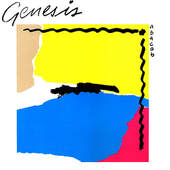Audio & Insights |
Beethoven Sonata for Piano and Violin Opus 12, No. 1
|
The 'rondo' is so frequently present as a musical form that it's almost not worth mentioning. And yet in some contexts – for example, in the context of Beethoven's chamber music – it's worth taking a closer look. Beethoven bent conventional forms with meaningful force, and filled them with rich music. It doesn't hurt to sketch the structure clearly, straightforward though it is; new perceptions can still follow.
 Rondo form is ubiquitous: for example, the English rock band Genesis refers to it, informally, in the title of its 1981 album 'abacab'. (Wikimedia: fair use)
Rondo form is ubiquitous: for example, the English rock band Genesis refers to it, informally, in the title of its 1981 album 'abacab'. (Wikimedia: fair use)
Almost any song with a recurring refrain might be called a rondo; usually they have an outline as shown below:
1. A section -- memorable theme
2. B section -- exploration, story
3. A section -- memorable theme, again
4. C section -- further exploration ('bridge')
5. A section -- memorable theme, yet again
6. B section -- something like the first B section
7. Some way to finish.
So here is a brief tour, section by section, of the last movement of the sonata for Piano and Violin, Op. 12, No. 1, of Ludwig van Beethoven. A recognizable Rondo, with willful and characteristic interruptions engineered by a young and clever composer.
1. A section -- memorable theme
2. B section -- exploration, story
3. A section -- memorable theme, again
4. C section -- further exploration ('bridge')
5. A section -- memorable theme, yet again
6. B section -- something like the first B section
7. Some way to finish.
So here is a brief tour, section by section, of the last movement of the sonata for Piano and Violin, Op. 12, No. 1, of Ludwig van Beethoven. A recognizable Rondo, with willful and characteristic interruptions engineered by a young and clever composer.
A: Rondo 1 -- Theme
The main theme could hardly be simpler. It comes once in the piano, and once in the violin, as a familiar-sounding country dance.
Eight bars, played twice: it is good-humored, and ripe to be remembered.
Eight bars, played twice: it is good-humored, and ripe to be remembered.
B: the 'B Section'
The first 'B section' doesn't offer large surprises. There is some virtuosity for players to navigate; there are some variations of material and mood; there are familiar and welcome explorations.
A1: Rondo 2 -- Theme, interrupted
The second rondo theme comes back harmlessly at first in the piano alone – as expected – but the violin immediately takes a darker direction and takes the whole theme for a longer ride. The jumping sixteenth note rhythm from the theme gets kicked higher and higher, as the stakes seem to rise.
C: Lyric departure
And then comes a whole new mood, a whole new key. What had seemed a troubled departure in the second rondo opens up a door to unexpected lyricism.
A: Rondo 3
When the Rondo returns, it has regained its balance: this time, no minor keys, and a simple trade of the theme and accompaniment between piano and violin.
B: B Section #2
The first 'B' section reappears, somewhat intensified, and with a bit of material at the end that sounds like it could bring a coda. But instead it brings...
B... a small Harmonic Train Wreck
Suddenly, we seem to be headed for E-flat major.
Coda 0: (A material): or perhaps 'Rondo 4' – finding the home key.
The rondo theme reappears, and the skipping sixteenth/dotted-eight rhythm quickly shows the way out of the woods. It too seems to be bringing things to a close.
Coda 1 (C material): -- The Lyric section, solved.
The C section ('lyric departure', above) had some unfinished business, and it reappears now with a sense of closure.
Coda 2: -- Jokes and Fragments from the main theme
The last word belongs to the smallest element: the little skipping rhythm, testing out keys and chords, until it finds home again.
© Timothy Summers